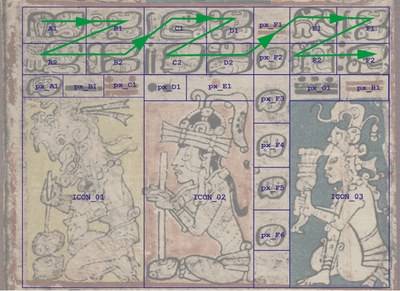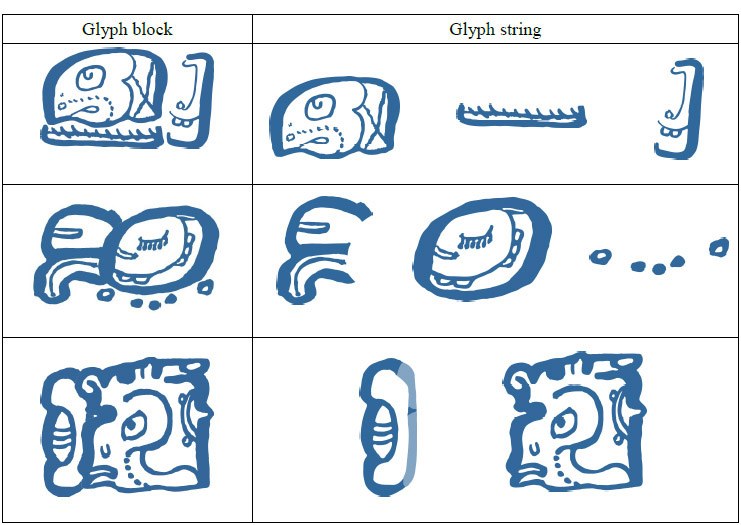Maya Codex
Description
The Maya Codex Dataset contains high-quality representation of Maya hieroglyph data, extracted from the three surviving ancient Maya codices (the Dresden, Madrid and Paris codices). See Fig. 1 for an example codex page. A statistical glyph co-occurrence model, which is extracted from the Thompson catalog [1], is also included.

Fig. 1. Detailed template of Dresden Codex page 6b, showing individual constituting elements framed by blue rectangles (glyph blocks, captions, calendric signs and icons). Green arrows indicate reading order of the blocks. (by Carlos Pallán based on Förstemann 1880 and 1892 facsimiles. High resolution images of the whole codex are available at SLUB website [2].
The dataset is generated by epigraphers in our team. The current dataset contains 174 reconstructed high-quality glyphs segmented from 72 blocks, together with the corresponding annotation for each individual glyph. Fig. 2 illustrates the main steps to produce the high-quality reconstructed vectorial image.

Fig. 2. Left: Original glyph block, cropped from a codex page. Middle: clean raster image. Right: reconstructed vectorial image.
In order to encode the context information, glyphs segmented from each block are arranged in the form of a string according to the reading order. Fig. 3 illustrates three example blocks, and the generated glyph strings.

Fig. 3. Example glyph blocks and the generated glyph strings based on reading order.
Usage
This dataset can not only be used as a shape analysis benchmark, but also to study the ancient Maya writing system. In [3] we conduct automatic Maya hieroglyph retrieval on this dataset, with experimental results reported in the paper.
Please following the instructions from the 'download' link (top left of this page) to download this dataset.
Reference
If you use this dataset, please cite the following publication:
@inproceedings{Hu2014,
author = {Hu, Rui and Gayol, Carlos Pallan and Krempel, Guido and Odobez, Jean-Marc and Gatica-Perez, Daniel},
title = {Automatic Maya Hieroglyph Retrieval Using Shape and Context Information},
booktitle = {Proceedings of the ACM International Conference on Multimedia},
series = {MM '14},
year = {2014},
isbn = {978-1-4503-3063-3},
location = {Orlando, Florida, USA},
pages = {1037--1040},
numpages = {4},
url = {http://doi.acm.org/10.1145/2647868.2655044},
doi = {10.1145/2647868.2655044},
acmid = {2655044},
publisher = {ACM},
address = {New York, NY, USA},
keywords = {glyph co-occurrence, image retrieval, markov model, maya hieroglyph, shape descriptors},
}
[1]. J. E. S. Thompson. A catalog of Maya Hieroglyphs. University of Oklahoma Press, 1962.
[2]. Saxon State and University Library Dresden (SLUB) library. http://digital.slub-dresden.de/werkansicht/dlf/2967/1/
[3]. R. Hu, C. Pallan-Gayol, G. Krempel, J.M. Odobez, and D. Gatica- Perez. Automatic maya hieroglyph retrieval using shape and context information. In ACM MM, pages 1037–1040, 2014.